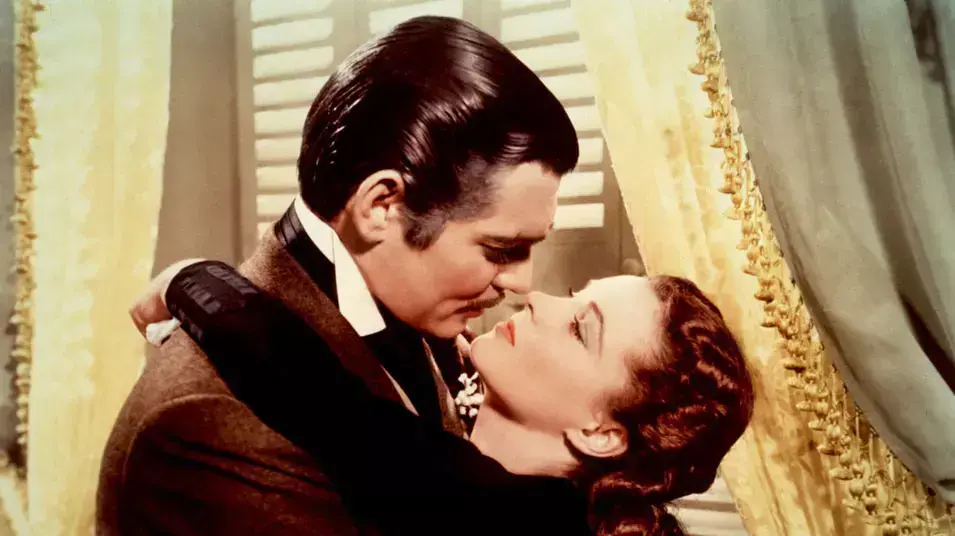After all, a new day tomorrow: 80 years for "Gone with the Wind"
The casting saga around the character of Scarlett O'Hara, the boycott of the festive film premiere, the changes in the director's chair - we returned to the little stories that made "Gone With the Wind" the greatest movie of all time
After all, a new day tomorrow: 80 years for "Gone with the Wind"
Scarlett O'Hara is a seemingly impossible combination of innocence and feminine power, between resourcefulness and wisdom and a basic misunderstanding of the reality that surrounds her - at the same time an early feminist icon and a woman trapped in romantic notions that are incompatible with reality(The article was first published in 2014, marking the 75th anniversary of the film's release)
This week, Hollywood marks eighty years for its biggest movie premiere. Not necessarily the best movie, but definitely the greatest: the one that is talked about the most before, during and after the production. The one that symbolizes Hollywood glory more than anything. Even if this year, the movie was ejected from the list of 150 dollars that earned the most dollars of all time (as of this writing, it is in 151st place), in calculating inflationary change, the amount earned "gone with the wind" in the US at the time equals double the amount of money earned by "Avatar" - The most box office movie of all time The second film on inflation-minded earnings list is the first "Star Wars", but also far from the achievements of "Gone with the Wind" in the gap that allows for another blockbuster.
The film was also the first to pick up a double-digit number of the Academy Awards, with ten figurines including for the film, director and more or less any category that is not the lead actor, in which film star Clark Gable lost the Robert Dont award for "Be Hello, Mr. Chiefs." Or in other words - an actor who only filmmakers remember his name on the film that says nothing to a wide audience.
The film's special status is not only due to its high-budget production, stars and extras that showcase all the grandeur that classic Hollywood could produce, but also because of the many themes presented in the film, directly or indirectly. On the face of the plot is not much different from a typical telenovela: the heroine of the film Scarlett O'Hara, in love over the head with a man who is obviously in love with another woman, while the perfect man Rhett Butler is in love with her. Scarlett will realize that she is in love with Brett only after she loses it.
Scarlett O'Hara is a seemingly impossible combination of innocence and feminine power, between resourcefulness and wisdom and a basic misunderstanding of the reality that surrounds her - at the same time an early feminist icon and a woman trapped in romantic notions that are inconsistent with reality. She is brave enough to kill an opposing soldier who invades her estate after the war, and on the other hand is abused by her husband and it seems that the thought of a complaint does not even occur to her. These contrasts in the main character are similar to the world in which the film depicts nostalgic feelings - the aristocracy of the United States, a world in which the film's first half focuses. And the South's lack of understanding that its world of values is about to suffer defeat, not just military.
We totally responded to a dam (from "Gone with the Wind")
Gone with the Wind (Photo: Screenshot)
The film's attitude to the South facing collapse also describes another thing that doubts how much the filmmakers were aware of during filming - the world of classic Hollywood is also about to pass awayMuch of the film's charm comes from providing something for the entire audience - it was based on an award-winning book and American history, was very exciting for melodrama lovers and presented huge scenes of war to satisfy epic buffs. All the target audiences that Hollywood thought of could find what they wanted in the movie - especially when it was marketed in advance as a one-off cinematic event. Every audience that Hollywood thought of at that time was made up of white-skinned people, by the way.
The film's attitude to the South that is facing collapse also describes another thing that doubts how much the filmmakers were aware of during filming - classic Hollywood's world is also going to wind down, due to the establishment of employee committees and later US legislation that would make it difficult for such productions in the future. Therefore, "Gone with the Wind" is a symbol of Hollywood cinema at its height and also a eulogy not only for the southern world depicted in it, but also for the Hollywood queen who created it. As such, it became a myth, probably when it was built like that long before filming began. That's how it became as the film became the life of independent distributor and PR artist David O. Slznik.
Some readers may be rubbing their eyes at the word "freelance" - "Gone with the Wind" the high budget seems to be the complete opposite of what is now known as freelance cinema, but in the 1930s, the concept of freelance had a completely different meaning. Each of the major Hollywood studios has created about 52 films this year - which means enough to release a movie each week. Since both movie theaters and movie distribution systems were owned by the studios, a large studio could only survive very well with its produce. But when you make a movie every week, not every movie gets the same attention. Independent producers specialized in producing two to three films a year, but put a lot of effort into smoothing each film. While the big studios have signed a very large number of actors, screenwriters, and directors on long-term contracts, the independent producers have held very few talents under contract. In fact, two independent producers stood out above the rest: Sam Goldwin and David O. Slznik. With the production of "Gone with the Wind", Selznick opened a consciousness gap that made him the name most closely associated with the term Hollywood producer ever since.
This gap opens up about the public relations system that gave "Gone With the Wind" status of a cinematic event and myth. The movie was an underdog and a prestigious event at the same time from his birth. First, Selznick worried that Hollywood media would report that most Hollywood studios rejected the option to acquire the rights to Margaret Mitchell's book. This, by the way, included Seleznik himself. The author's representatives offered him the book before it was published and, like all other studio executives, a story about the vanquished side of the civil war seems to be too much of a financial risk, probably for those who produce a small amount of films a year. But after a second thought, Selznik nevertheless decided to purchase the book, near the time it was officially published. Mitchell's book has been a success and awards, and Selznick has begun to give reporters stories about the difficulties of the production and most of all about the search for the actress who will play Scarlett O'Hara, the main character in the saga.
Without a doubt, the greatest movie of all time (from "Gone with the Wind")
Gone with the Wind (Photo: Screenshot)
Unlike the lead actress, Selznik knew who he was appointing to the role of Rhett Butler from the beginning. Butler's charismatic character had to be embodied by someone in those years called "Hollywood King" - Clark GableThroughout the film and the book, Scarlett is endlessly dealing with the deaths of family members, defeat in the war, assault inside and outside the house, and especially romantic disappointments. But it may be that the actress search saga that embodies it was even longer. Slasnick conducted cloth tests for every woman in Hollywood, more or less. About 1,400 actresses were tested for the role and wanted to see if the entertainment newspapers of the era mentioned their name as a nominee. The casting saga took a long time, and after the Davis Tribes did not pass its audition, Warner Bros. Studios decided to produce their own Civil War saga to compete in "Gone with the Wind." The film, "Isabelle," went on screens about a year before "Gone with the Wind" was shot and Betty Davis won the Academy Award, while "Gone with the Wind" finally took photos.
As Vivian Lee read Mitchell's novel, she knew the role was perfect for her. Except my British wasn't at all on Slznik's radar, even though Slznick was well versed in British cinema (he's the man who brought Hitchcock to Hollywood) and appreciated Lee's ability, he didn't think anyone in the US could play the role. Lee who went to Hollywood persuaded Selznik to give her a chance during a dinner where the two attended. The audition was successful and Selznick went on to market Lee, who was already a star in the UK, as the anonymous actress born to play Scarlett and personally endorsed by Margaret Mitchell.
Unlike the lead actress, Selznik knew who he was appointing to the role of Rhett Butler from the beginning. Butler's charismatic character had to be embodied by someone who was called "Hollywood King" in those years - Clark Gable. But the production manager at MGM Studios, Louis Bee. Meier, refused to release Gable to studios or other producers. Slasnik hoped for protection because he was married to Meyer's daughter at the time, but that didn't help. After contacting other Hollywood actors, Selznik returned to the idea that the role belonged to Gable. He eventually got to ask the star for his film in exchange for transferring the film's distribution rights to MGM, along with agreeing to a 50 percent profit distribution. Since the film was also going to become very expensive to produce and Selznik had already poured quite a bit of money on him, any result except making the film a scale that Hollywood did not know could have eliminated Selznick's career as a producer.
Playwright Sydney Howard was entrusted with writing the script, but after he finished his part, at least three other screenwriters would write the script without getting credit, and the most massive rewrite performed by Selznik himself. During the filming, he was also named Ben Hecht, another senior screenwriter, who wrote the script and sometimes worked on scenes on the day they were filmed.
The director's chair went through even more turbulent upheavals. The original director of the film was George Kyokur, one of Hollywood's esteemed. After about three weeks of filming, he was fired by Selznik, allegedly due to artistic disagreements with the producer. The myth claims that it was actually star Clark Gable who demanded the layoffs - Kyocor later claimed that Gable was uncomfortable working with a director who is identified as producing good acting shows for women and not necessarily men. Another claim is that Gable was uncomfortable working under Kyokur due to being a gay director - there are also gossip experts who claim that Gable's recoil was not of her sexual orientation, but that Kyokor knew that before becoming a star, Gable made a living by providing escort services to Hollywood men.
From "Gone with the Wind" (screenshot)
Gone with the Wind (Photo: Screenshot)
Another fight that Selznick has a lot to discuss in the media is the fight against Hollywood censorship. Szelnik insisted on keeping the spirit of the book with the character of Clark Gable saying the curse "Damn" - a pretty innocent curse back thenThe director who replaced Kyokur was Victor Fleming, a less esteemed director but one who has worked with Gable in the past in a line of hits of a more masculine nature than "Gone With the Wind". Fleming was named "Gone with the Spirit" before he could finish his work on his previous film, The Wizard of Oz - which is the second 1939 film to have received cult status to date. The reason Fleming received the "Wizard of Oz" in general was that the original director, George Kyokor, was chosen to direct "Gone with the Wind." That did not end with the changes in the director's chair - after a few weeks, Fleming retired from production due to exhaustion and third director Sam Wood replaced him for a short time. Eventually Fleming returned to the final stage of filming. Throughout this time, the two main actresses in the film kept secretly instructing George Kyokur.
The exhaustion that caused Fleming's temporary retirement could have been understandable - the movie was filmed for just over five months with almost no rest days during them, and when the work day starts early and sometimes ends late at night. Salznick was lucky in that respect - shortly after the filming ended, the unions' activities, which began to set restrictions on the length of the workday, succeeded - up to eight hours, in addition to a weekend break. If Selznick would launch a little later, filming time and the film's budget would have increased a lot. During the filming of the film, Salznick had to rely on the loyalty of the editors who worked closely with him for as long hours as the strike of the Editors' Union was at stake.
Another fight that Selznick has a lot to discuss in the media is the fight against Hollywood censorship. Szelnik insisted on keeping the spirit of the book in which the character of Clark Gable says the curse "Damn" - a pretty innocent curse back then, but in those years Hollywood cinema did not suffer any curse of any kind, and the struggle to get approval on this topic gained the proper public relations. By the way, the year before that word was said in a Hollywood movie when Catherine Hepburn quoted from Macbeth in the movie "Holiday."
The premiere of "Gone with the Wind" was set for December 15, 1939, and the film was almost unprepared by the deadline, when, eventually, weeks before filming, Selznick managed to put together a final four-hour version. Selznick chose the premiere not in Hollywood or New York as usual, but in Atlanta, the largest southern city in which some of the film takes place and one of the highlights of the film is on fire. Most of the stars and moviegoers made their way to the city, but not everyone could take part in the premiere. The film's signed screenwriter, Sydney Howard, was killed in a tractor accident over the summer. Leslie Howard, who portrayed Ashley Wilkes in whom Scarlett is secretly in love, volunteered to work in the British Army at the outbreak of World War II - he filmed films and participated in radio broadcasts for the military and eventually was killed by a Nazi attack during his later role in the war.
More on the same topicBetter late: "Gone with the Wind" was returned to the library 65 years late
To the full articlePromote African Americans? (From "Gone with the Wind")
Gone with the Wind (Photo: Screenshot)
As stealing the show as stealing the showFrom today's loans to everyone it's like, no matter what row or chair you sit on
Subject to the terms of financing Ltd. and to the underwriting conditions. Failure to meet the loan repayment may result in a charge on arrears and execution proceedings
For a 1939 loan, racism still ruled the southern US openly and African-American actors in the film, including Hattie McDaniel who played a minor role as Scarlett's maid, were not invited to the celebration. Gable was furious and decided to boycott the premiereAnother absence from the premiere almost also resulted in the absence of big star Clark Gable. In 1939 racism was still overtly controlled in the southern US and African-American actors in the film, including Hattie McDaniel who played a minor role as Scarlett's maid, were not invited to the celebration. Gable was furious and decided to boycott the premiere, which he personally still thought the movie "female" Eventually, and after a persuasive campaign that included the self-confessed actress, Gable waved to the southern audience, and soon McDaniel became the first African-American to win an Oscar - and soon to be the first actress to win. African American, a claim that looks particularly angry when watching today's movie.
Already in 1939 there were quite a few voices in the US against the minority attitude in the movie, but they were engulfed in the public blitz that made the long movie the biggest myth Hollywood created, regardless of being a good movie. High quality - he purports to give the aristocratic southern audience himself a taste of the pinnacle of the great Hollywood realm of life - two glamorous cultures that may not have been so great at their peak - only their downfall was magnificent enough to give them greatness. And Hollywood won't make another big movie like it.
Even if the process that eventually led to the classic Hollywood system crash took about two decades, and even unlike the southern U.S. Hollywood rebuilt itself. Hollywood didn't have a more glorious year than 1939 and this year, or every other year, a movie that came To the splendor of "Gone with the Spirit."















